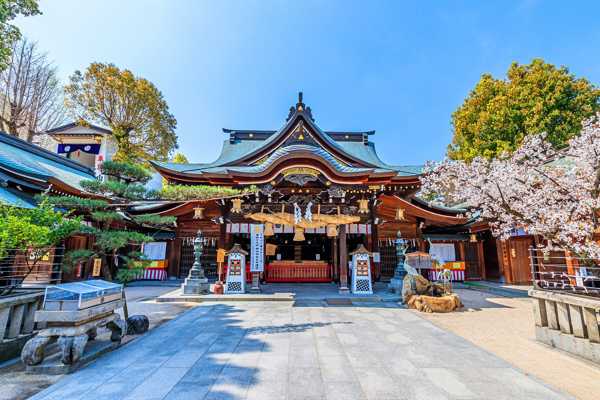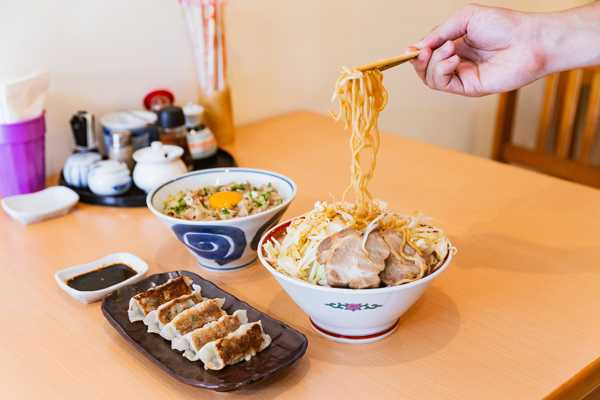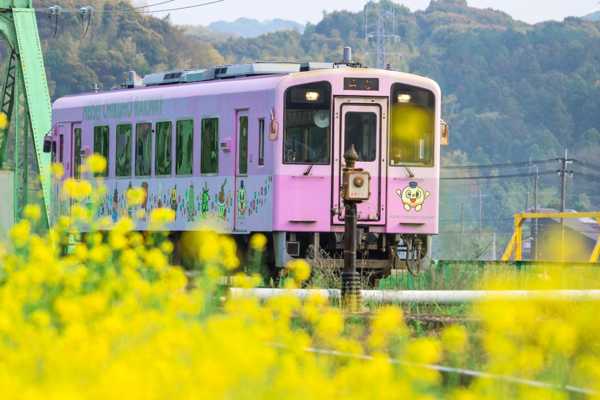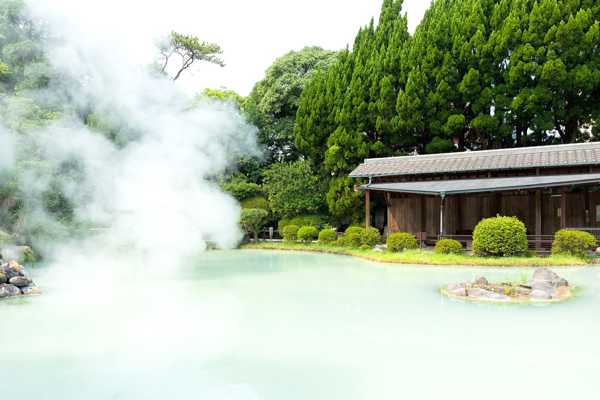Kyushu and its capital city of Fukuoka is known for being one of Japan's top spots for good, honest, and tasty food. The sheer number of local delicacies here means that it can be difficult to choose. People typically enjoy the evenings by strolling around and trying out whatever takes their fancy from the carts selling Hakata specialities such as pork broth ramen (tonkotsu ramen), grilled chicken skewers (yakitori), hot-pot vegetable and offal stew (motsu-nabe) and dumplings cooked in iron pots (tetsunabe gyoza).
If you’re a seafood lover, get up early in the morning and head to the market in the city where you can enjoy a breakfast of fresh fish caught in the Genkai Sea. If that has whetted your appetite, join us as we explore the mouth-watering foodie highlights of Kyushu and Fukuoka!
- 1
Hakata tonkotsu ramen

- Ruoka
Hakata tonkotsu ramen is top of the list when it comes to the local dishes of Kyushu. These are straight and very thin noodles in cloudy broth prepared by boiling pork bones for hours on end, and you can normally choose your preferred firmness of noodle. The Kaedama system to have an extra serving of noodles is unique to Hakata tonkotsu ramen.
Ingredients are relatively simple: roasted pork (char siu), green onion, and wood ear mushroom. You can then add toppings such as spicy pickled mustard and green and red pickled ginger. Depending on the speciality of the restaurant, the flavour can vary from thick, rich soup to light soup without a strong pork bone scent. Your quest is to find your favourite ramen in Fukuoka, a hotspot of Tonkotsu Ramen.
Valokuva: vigorous_action (CC BY-SA 3.0) muokattu
- 2
Hakata udon

- Ruoka
Sanuki udon noodles and Kansai-style udon are well-known local udon dishes, but Hakata has its own spin on the genre. Hakata udon noodles are soft and tender, served in a clear soy sauce-flavoured soup made with shredded bonito, flying fish, dried small sardine and kelp. One of Hakata udon’s unique toppings is a circular fried fish cake. A little confusingly, it’s known as maruten in Hakata, where fish cakes are also called tempura.
Udon noodles with maruten is a popular local dish that was introduced in a popular TV series called Solitary Gourmet. Another topping, every bit as popular as maruten, is burdock tempura. This is not fish cake, but rather regular tempura fried with batter. Add a lot of green onion on top of the mild-tasting broth and enjoy.
Valokuva: Nissy-KITAQ (CC BY-SA 3.0) muokattu
- 3
Fresh seafood cuisine

- Ruoka
In Fukuoka, fresh seafood from Genkai Sea is offered on the same day as the catch. You really must try the sushi and fresh seafood rice bowls (kaisen don) here. There are even Japanese-style bars (izakaya) run by fishmongers, where you can enjoy excellent sashimi or nigiri sushi. It’s only in Fukuoka, which is surrounded by sea, that you can enjoy ingredients directly sent from Yanagibashi Rengo Market or Nagahama Fish Market as soon as they arrive from the trawlers. Seafood rice bowls are maybe the best choice if you just want delicious fish.
For lunch, there are so many varieties available at affordable prices. Just look for the lunch menus at any izakaya. Or if you’re looking for a special dinner, you can’t go wrong at a sushi restaurant where chefs prepare the sushi specifically for you. This type of restaurant offers a perfect window in which to appreciate the chefs’ delicate handiwork.
- 4
Karashi mentaiko

- Ruoka
One of the most famous specialities of Fukuoka is spicy cod roe (Karashi mentaiko). It’s available all over Japan now, but the authentic taste is still special in this part of Japan. Karashi mentaiko is cod roe marinated and matured in a seasoning liquid. Each shop has its own version, so it’s fun to try them all. This dish is popularly eaten with rice or as a snack on while drinking. These days you can also find it sold in tubes, making it easy to use with pasta.
Originally a Korean dish, cod roe was marinated with red pepper and garlic in a recipe similar to that of Korean spicy fermented vegetables (kimchi). But with a few changes, spicy cod roe marinated in a seasoning liquid was launched in its own right in 1949. Since then, it has become very popular and is now one of the most famous souvenirs to pick up in Hakata. It’s probably best to buy some on the last day of your trip because it’s a fresh food, but some shops may ship it for you if you ask them.
Valokuva: Nissy-KITAQ (CC BY-SA 3.0) muokattu
- 5
Motsu nabe

- Ruoka
Tripe hot-pot (motsu nabe) is one of Fukuoka’s soul foods. This dish is a hot-pot (nabemono) with beef tripe and a good helping of vegetables such as Chinese chives and cabbage stewed together. It’s an energy-boosting dish popular not only in winter but also in summer to prevent fatigue from the summer heat.
Its fame has now spread all over Japan as a healthy dish that is low-fat, low-calorie, high-protein, rich in vitamins and collagen, but what better place to try it than here at its birthplace? The base soup flavour varies depending on the restaurant, ranging from soy sauce and soybean paste to kelp stock, but the classic flavour is soy sauce. Garlic and chilli pepper are added to the soup to further deepen the flavour. Adding various noodles to finish off the meal is a great way to enjoy the rich, flavourful soup until the very last drop.
Valokuva: Koji Horaguchi (CC BY 2.0) muokattu
- 6
Mizutaki

- Ruoka
Mizutaki is a Japanese hot-pot in which skin-on, bone-in pieces of local Hakata chicken are simmered in water. This is one of the area's most famous dishes. This dish has been chosen as one of Japan’s 4 major chicken hot-pot dishes, along with shamo nabe from Tokyo, kashiwa nabe from Kyoto, and kiritanpo nabe from Akita.
It’s popular as a home cooking dish in winter locally, but speciality restaurants offer Mizutaki set meals throughout the year. Although it seems to be traditional Japanese food, it was in fact invented by a Japanese man from Nagasaki who went to Hong Kong in the Meiji period and worked for an English family. The rich, cloudy broth is made by simmering bone-in chicken and is rich in collagen. The great thing about this dish is that aside from the chicken, you can also enjoy a lot of low-calorie and healthy ingredients such as vegetables and mushrooms.
Valokuva: Lucy Takakura (CC BY-SA 2.0) muokattu
- 7
Nakasu yakitori

- Halpa
- Ruoka
Skewered chicken (yakitori) is a highly popular local food in Kyushu. A little-known fact is that the consumption of chicken in Fukuoka is the highest of any prefecture in Japan. This seems to have started back in the Edo period when the Kuroda Clan recommended chicken farming as a speciality product for the area.
In Nakasu, the downtown part of Hakata, you can find many skewered chicken restaurants where they grill high-quality local chicken with charcoal. The leading dish here is chicken skin (torikawa) grilled over and over with a delicious sauce. It goes really well with beer. Pork belly is another classic dish at skewered chicken restaurants in Hakata.
- 8
Tetsunabe gyoza

- Ruoka
The birthplace of Chinese dumplings cooking in iron skillets (tetsunabe gyoza) is Yahata, Kita-Kyushu, which once prospered as an iron-producing town thanks to the Yahata Steel Works. Delicious dumplings that can be eaten quickly were very popular as an energy-boosting dish amongst the people working at the ironworks.
The dish became popular because of being served in an iron skillet and retaining its heat. Eventually, it became a classic dish at stalls in Fukuoka. Small and bite-sized, this is an ideal snack for people of all ages. As soon as you take a bite of a hot dumpling cooked on the skillet, the juicy rich flavour will fill your mouth. Make sure you try it with citrus pepper paste (yuzukosho) like the local people do.
Valokuva: Koji Horaguchi (CC BY 2.0) muokattu
- 9
Gameni

- Ruoka
Gameni is a dish in which root vegetables and chicken are sautéed together in oil and then slowly simmered. This is an essential Fukuoka delicacy at celebrations and happy occasions. Known as “Chikuzenni” in other regions, Gameni has become popular throughout Japan thanks to its inclusion in school lunches.
There are several theories that explain the origin of its name, one of which is that it came from the local dialect phrase “gamekurikomu”, which means to collect various things. As its name suggests, Gameni is a dish in which various ingredients – such as chicken, burdock, taro, carrot, lotus root, shiitake mushroom and bamboo shoot – are all simmered together. The flavours are deeply absorbed, so it’s very delicious even when cooled.
Valokuva: 南無観自在 (CC BY-SA 4.0) muokattu
- 10
Umegae mochi

- Ruoka
There are many shops that sell the famous Umegae mochi on the approach to the Dazaifu Tenmangu Shrine. Umegae mochi is a rice cake filled with delicately sweetened mashed red bean paste grilled on a griddle, and has a signature plum blossom branding. The name, which references plum, is based on the branding (it’s not actually plum-flavoured).
The origin story of Umegae Mochi is that an old lady brought it as comfort food to Sugawara no Michizane, who had been deported to Dazaifu and was leading a difficult life as a criminal. Umegae mochi is usually white, but on the 25th of each month, for Tenjin Day, there are green Umegae Mochi with yomogi leaves on sale, and on the 17th of each month, pink Umega mochi with ancient rice varieties are sold. Freshly grilled Umegae mochi is very fragrant. It’s best eaten on the spot.
Valokuva: ayustety (CC BY-SA 2.0) muokattu








